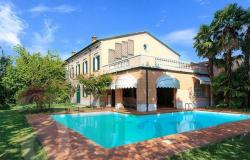2019 marks the 500th anniversary of Leonardo da Vinci's death, with events planned all over Italy. In Milan, where Leonardo lived for 23 years, working at the Sforza court, and producing some of his most memorable works, the “Leonardo 500” program officially kicks off in May with the reopening of the Sala delle Asse at the Sforza Castle. Leonardo decorated the vaulted ceiling with an intricate depiction of plant elements, including branches and knots all tangled together, trees, leaves, fruit, roots; closed for restoration since 2013, the room will reopen on May 16.
Among the scheduled exhibitions, there will be four at the Biblioteca Ambrosiana featuring drawings from the Codex Atlanticus, the largest set of drawings and writings by Leonardo containing 1,119 autographed sheets; the Fondazione Stelline will host an exhibition titled "The Last Supper After Leonardo", which includes contemporary artists' reinterpretations of Leonardo's masterpiece (opens April 1-June 30).
The Last Supper in the Cenacolo Vinciano, the refectory of the Church of Santa Maria delle Grazie, is indeed one of Leonardo’s most famous paintings, but getting to see it isn’t easy as reservation is mandatory and spots are usually taken months in advance – we have a few tips for you on how to get your tickets here.
The highlights of Milan’s “Leonardo 500” program is the return of the Madonna Litta painting, on loan from the Hermitage Museum in St. Petersburg, to which it was sold in 1865. The last time the Madonna Litta, a portrayal of the Virgin Mary breastfeeding baby Jesus, was in Milan was 30 years ago. It will be on display at the Poldi Pezzoli Museum as part of the exhibition "Around Leonardo: The Madonna Litta and the Artist's Workshop" from November 8, 2019 through February 10, 2020.
Scholars are divided over the attribution of the painting to Leonardo, with some arguing that it is the work of one of his students, Giovanni Antonio Boltraffio; the Madonna Litta will be on display at the Poldi Pezzoli alongside a masterpiece by Boltraffio that is part of the museum’s collection, the Madonna of the Rose, and other works by him and students of Leonardo.
During his Milan years, Leonardo produced such masterpieces as the Virgin of the Rocks, Lady with an Ermine, Belle Ferronière, in addition to The Last Supper and the Madonna Litta; he also started working on the Mona Lisa.
His activity wasn’t limited to painting though; he also designed and implemented hydraulic engineering works that are still in use today, such as the Miter Lock Gates, known as the Porte Vinciane, which serve to control the flow of water. The first were installed at Conca dell’Incoronata in Milan in 1496; modern water gates still follow the principle laid out by Leonardo in the Codex Atlanticus.
For a full list of events in Milan, see https://www.in-lombardia.it/en/visiting-lombardy/leonardo-500.








